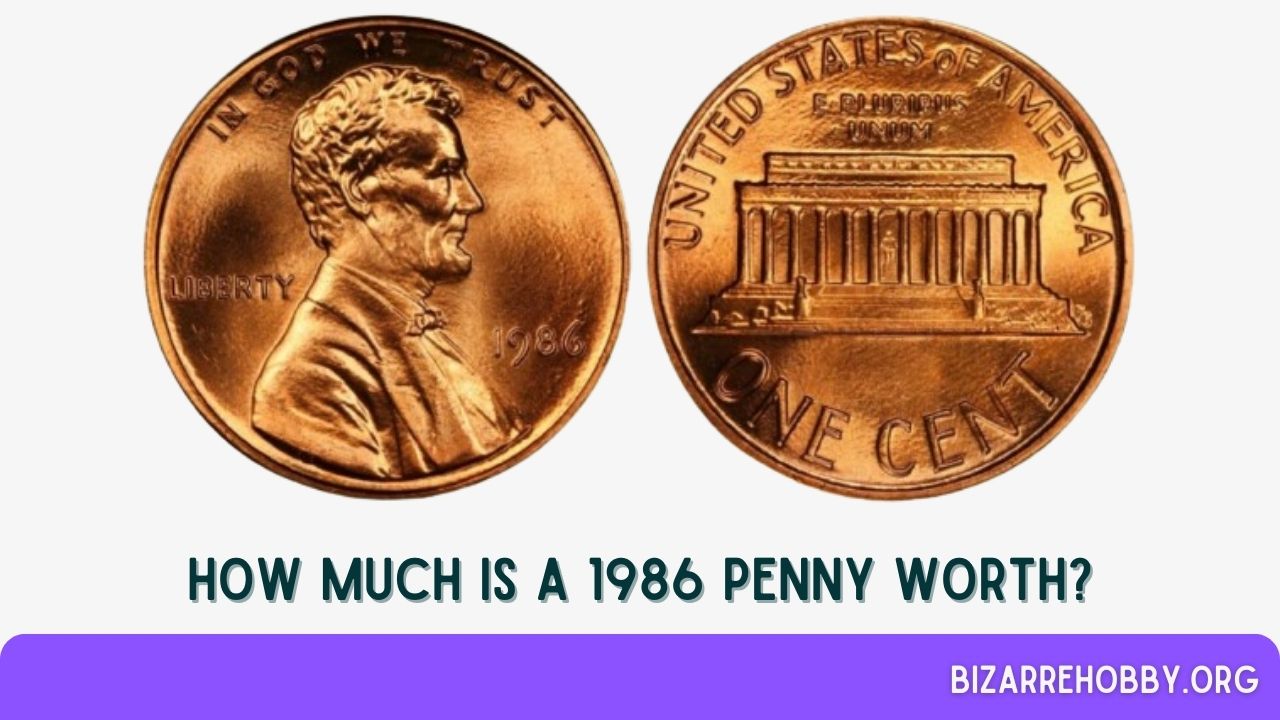Are you thinking about collecting 1986 pennies and curious about their potential value? Or perhaps you already own a 1986 penny and want to know its worth?
We have all the information you need about the value of 1986 pennies!
While pennies from 1986 are relatively modern in the context of U.S. coinage history, they generally don’t hold significant monetary value. However, their affordability makes them an excellent addition to any Lincoln penny collection without a hefty investment.
In this guide, you’ll uncover the true value of a 1986 Lincoln Memorial penny. We’ll explore the coin’s distinctive features, valuable error varieties, and provide tips on grading your penny.
So, let’s dive in and discover: how much is a 1986 penny worth?
Table of Contents
Value Chart for 1986 Penny
| Mint Mark | Good | Fine | Extremely Fine | Uncirculated |
|---|---|---|---|---|
| 1986 No Mint Mark Penny Value | $0.05 | $0.05 | $0.05 | $7.50 |
| 1986- D Penny Value | $0.05 | $0.05 | $0.05 | $7.50 |
| 1986-S Proof Penny Value | NA | NA | NA | $550 |
Historical Significance of the 1986 Penny
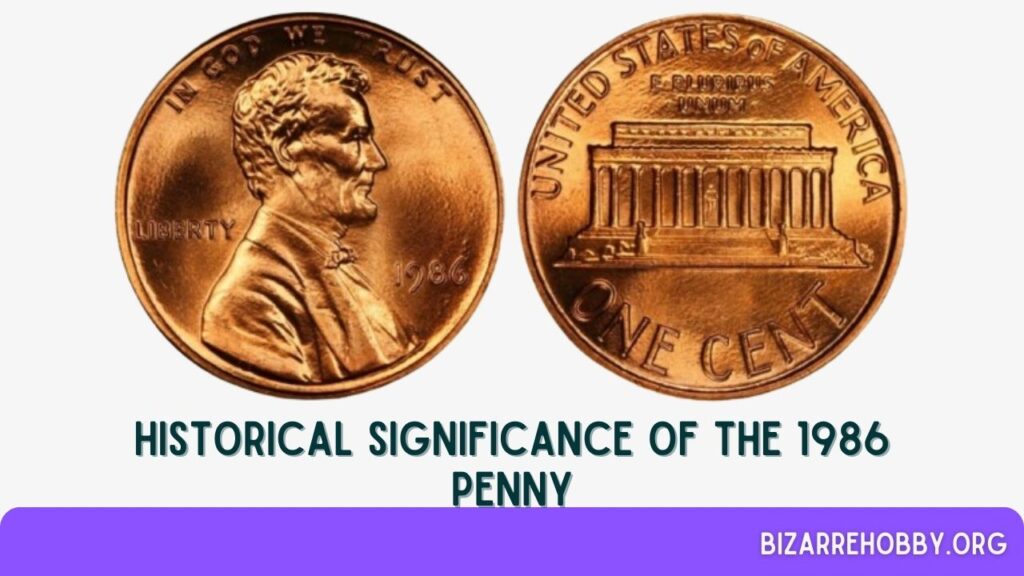
The 1986 penny is part of the Lincoln penny series, first introduced by the U.S. Mint in 1909. From 1909 to 1958, these coins were known as Wheat Pennies due to the depiction of two wheat ears on the reverse side.
As early as 1952, the U.S. Mint considered updating the reverse design. It wasn’t until 1958 that a decision was made to refresh the Lincoln penny’s appearance. The Mint enlisted renowned sculptor Frank Gasparro to create the new design, with significant input from the Lincoln Sesquicentennial Commission and the Treasury.
The updated design features the Lincoln Memorial in Washington, D.C., constructed between 1914 and 1922. Although Gasparro had never seen the Memorial in person, he successfully captured its essence on the penny.
Approved by the Secretary of the Treasury and President Eisenhower, the new design was released into circulation in February 1959, commemorating Abraham Lincoln’s 150th birthday.
Rising copper prices in 1973 increased the intrinsic value of Lincoln pennies, leading to widespread hoarding. To address this, the Mint experimented with different metal compositions. In 1983, facing another copper price surge, the Mint changed the penny’s composition to zinc with an outer copper layer, a composition that remains largely unchanged today.
Like other Lincoln pennies, the 1986 penny holds significant historical and sentimental value, making it a worthy addition to any collection.
Next, let’s examine the designs of the 1986 Lincoln penny.
Design of the 1986 Penny
The 1986 penny shares many characteristics with other Lincoln Memorial pennies minted since 1959. Understanding these features can help you identify valuable 1986 pennies.
Obverse Design of 1986 Penny
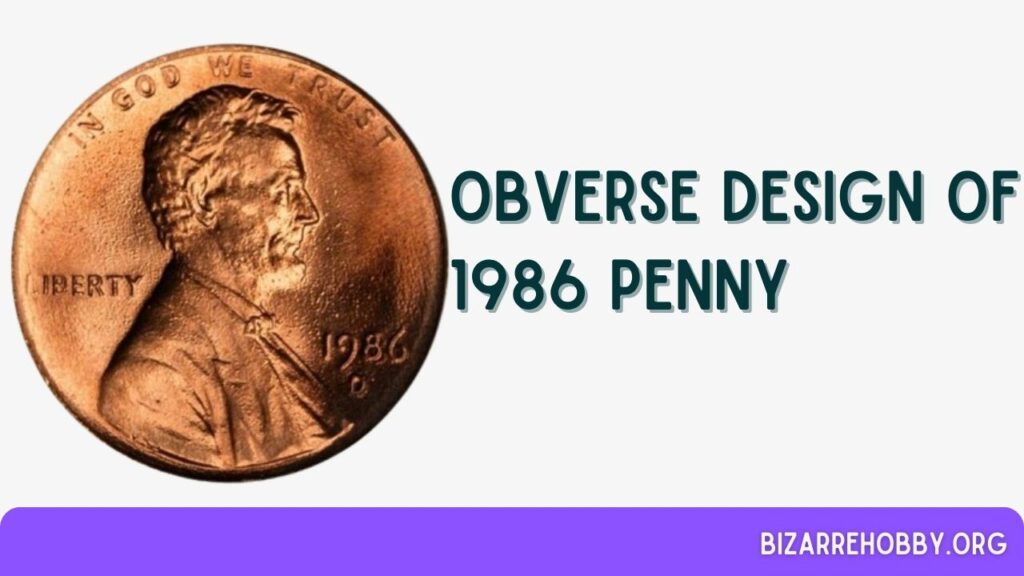
The obverse side of the 1986 penny prominently features a right-facing portrait of Abraham Lincoln, dressed in a suit and bowtie. Above Lincoln’s head, you’ll find the national motto, IN GOD WE TRUST. To the left of the portrait is the word LIBERTY, and to the right, the year 1986 is inscribed.
Reverse Design of 1986 Penny
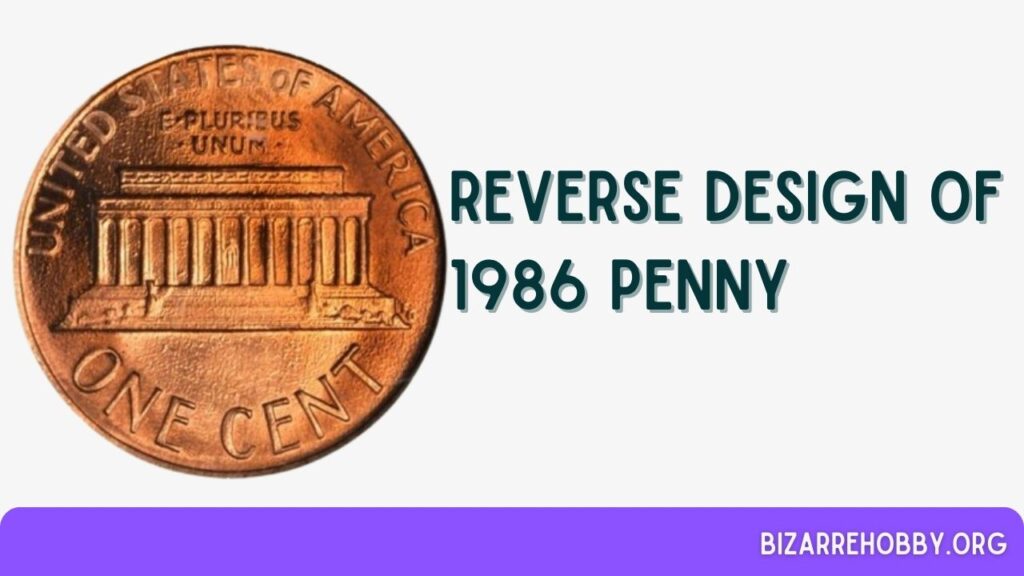
The reverse side of the 1986 penny is more intricate. The central feature is the Lincoln Memorial, symbolizing the nation’s respect for Abraham Lincoln. At the top of the coin, you’ll see the inscription UNITED STATES OF AMERICA, followed by the motto E PLURIBUS UNUM, which translates to “Out of many, One.”
If you look closely, you can spot Lincoln’s statue inside the Memorial. Additionally, the initials FG for Frank Gasparro, the coin’s designer, are located on the far right. The denomination ONE CENT is displayed at the bottom along the inner rim.
Technical Specifications of 1986 Penny
The 1986 Lincoln penny has a diameter of 19.00 millimeters and weighs 2.5 grams. It has a plain edge and is composed of a copper-plated zinc core. In mint condition, these pennies exhibit a reddish hue due to their copper coating. However, exposure to the elements can cause them to turn brown or red-brown over time.
Grading Guide for 1986 Penny
When collecting 1986 pennies, it’s advisable to focus on uncirculated pieces, as circulated ones are typically worn and less valuable. In average grade, circulated coins will show significant wear, with merged letters and a barely visible date. The reverse details, including the Memorial and wheat ears, may also be faint.
To be graded as uncirculated, a 1986 penny must exhibit exceptional luster, a strong strike, and appealing eye quality. These coins should be free from contact marks, scuffs, or hairlines, and the planchet should be flawless.
Here’s a quick reference for Sheldon grading:
| Sheldon Scale | Grade |
|---|---|
| 1 | Basal State-1 |
| 2 | Fair |
| 3 | Very Fair |
| 4, 5, 6 | Good |
| 7, 8, 10 | Very Good |
| 12, 15 | Fine |
| 20, 30 | Very Fine |
| 40 | Extremely Fine |
| 50 | About Uncirculated |
| 60 | Mint State |
| 65 | Mint State |
| 70 | Mint State |
Please read my Lincoln Wheat Penny grading guide to accurately determine your coin’s grade, which is essential for assessing its value.
1986 Penny Value Guides
So, how much is a 1986 penny worth?
The value of your Lincoln penny depends on several factors, including its condition, color, rarity, mint marks, and any errors it may have. Generally, pennies in mint condition are more valuable than circulated ones, and red pennies tend to be worth more than their red-brown or brown counterparts.
Let’s explore the value of the three main varieties of the 1986 penny:
1986 No-Mint Mark Penny Value
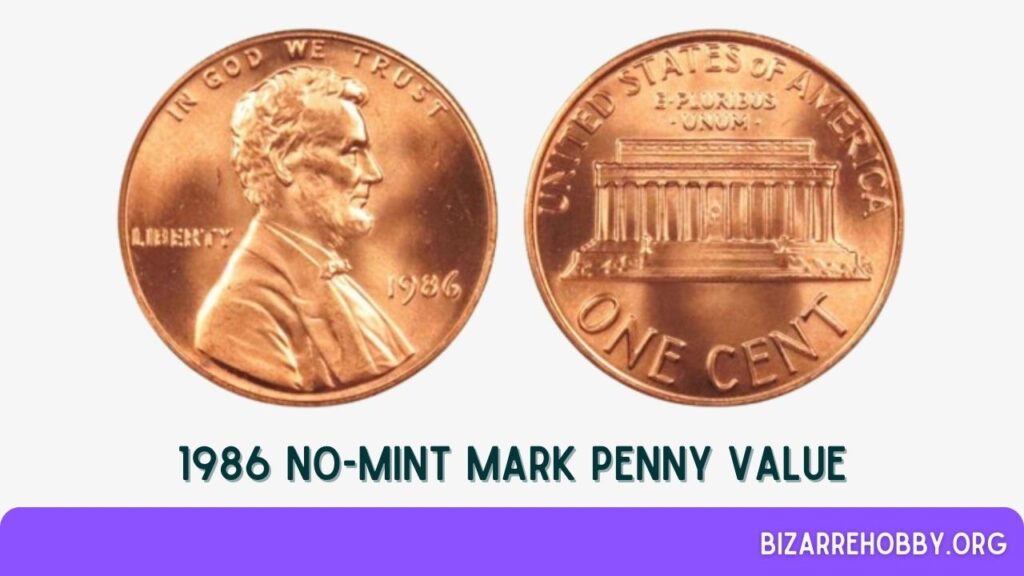
The Philadelphia Mint produced a staggering 4,491,395,493 Lincoln pennies in 1986. As is customary, these pennies do not have a mint mark. Due to their high mintage and relatively recent production, 1986 pennies are still commonly found in circulation. Circulated examples are typically worth between $0.05 and $0.10, which is close to their face value.
The abundance of 1986 no-mint mark pennies means that even uncirculated examples are quite affordable. For instance, an MS66 penny from 1986 is valued at around $5.
However, full red pennies from this year are extremely rare, with fewer than 100 known examples. A full red MS68 penny can fetch around $200, and the most expensive 1986 penny, a full red MS68 specimen, sold for an impressive $2,400 at an eBay auction.
1986-D Penny Value
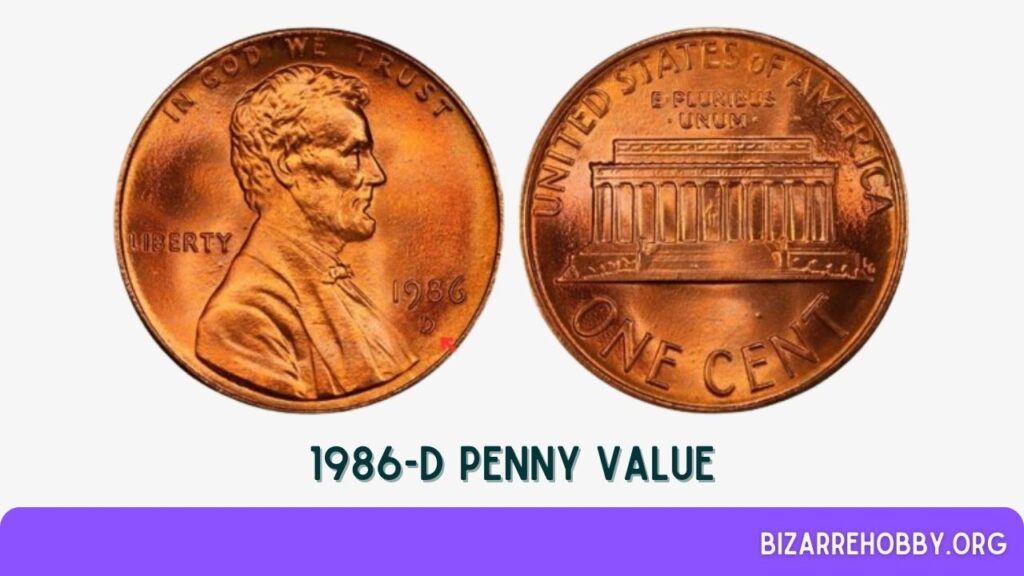
The Denver Mint also had a high production year in 1986, minting 4,442,866,698 pennies. These coins are generally worth their face value, with circulated examples fetching between $0.05 and $0.10. It’s worth noting that the Philadelphia Mint produced higher quality coins compared to the Denver Mint.
Despite this, 1986-D pennies are still very affordable, even in mint state. A brown, gem-quality example can be acquired for just $7.50. Red-colored pennies from the Denver Mint are more valuable, with prices reaching up to $100. In 2021, a collector paid an astonishing $7,840 for a red gem graded MS69.
1986-S Proof Penny Value
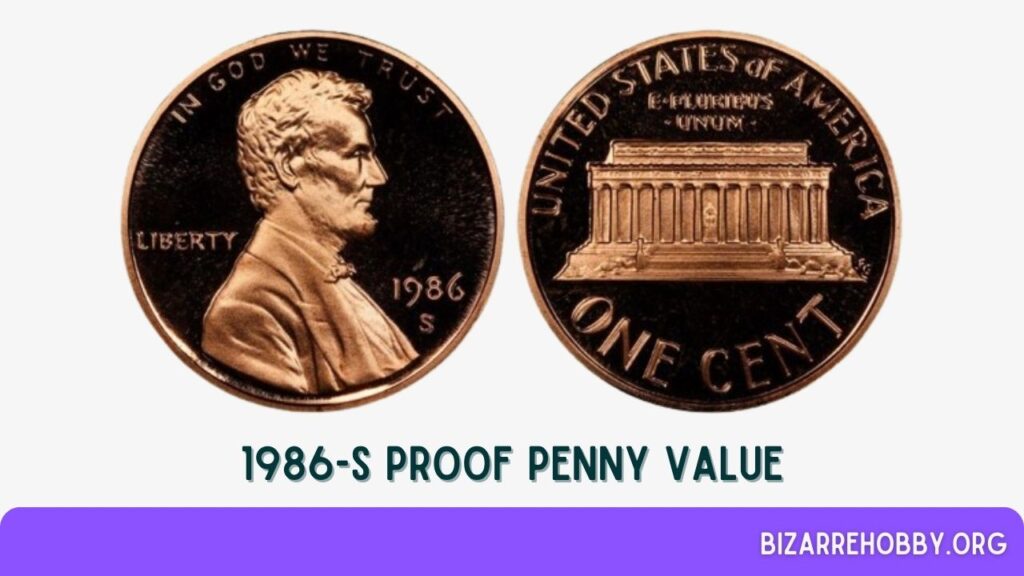
In addition to regular strike coins, the U.S. Mint also produced proof coins for collectors in 1986. The San Francisco Mint struck 3,792,233 proof pennies, making them readily available for collectors. Proof coins are distinguished by their brilliant luster and frosted surfaces, along with a higher quality strike and minimal errors.
While proof coins are typically more valuable than regular strike coins, this isn’t always the case for high mintage years like 1986.
For example, a 1986 proof penny graded PF66 can be acquired for about $5, while an MS68 example might cost around $8.50. Gem-quality proof pennies from 1986 are extremely rare, with only a few known examples fetching up to $550.
Rare 1986 Penny Error List
While 1986 Lincoln pennies may not be highly valuable in general, certain minting errors can significantly increase their worth. Here are some notable 1986 penny errors that collectors seek:
1986 Off-Center Strike Penny Error
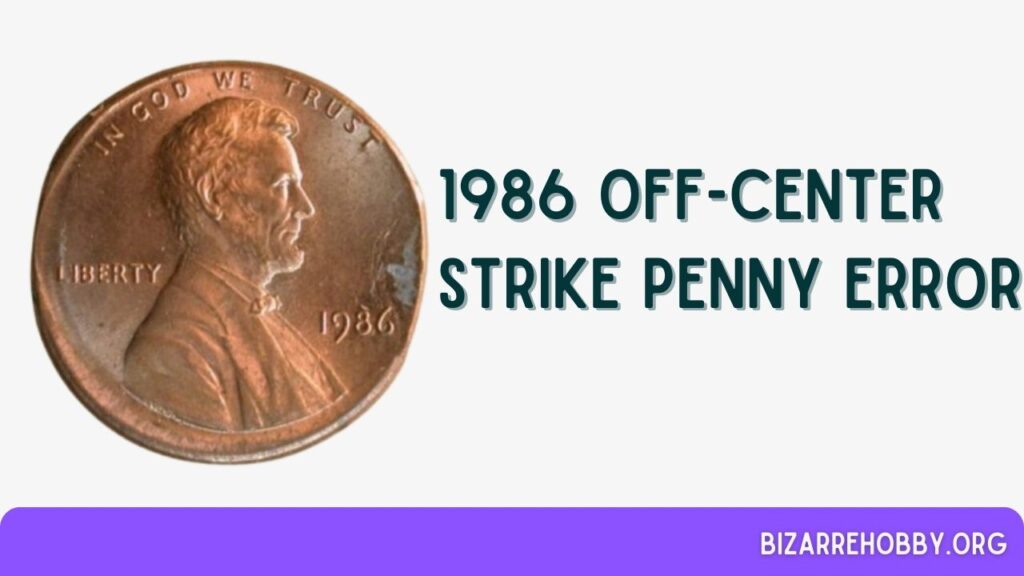
Off-center strike errors occur when the planchet is not properly aligned with the striking die, causing the design to be struck away from the center. The value of an off-center strike depends on how far the design is from the center.
Off-center strikes that are more than 50% off are typically more valuable. Some 1986 pennies exhibit about a 30% off-center strike error, which can be worth up to $65.
1986 Wide AM Penny Error
The wide AM error is unique to Lincoln pennies and refers to the spacing between the letters “A” and “M” in “UNITED STATES OF AMERICA.” In some pennies, the space is noticeably wide, while in others, the letters are unusually close.
These variations are believed to result from changes in the die used to design the coins. Both wide and narrow AM pennies are highly sought after by collectors, with wide AM 1986 pennies in mint state fetching up to $260.
1986 Missing Copper Clad Penny Error

The 1986 Lincoln pennies are composed of a zinc core with a copper outer layer. In some cases, the outer copper layer may be missing due to a minting error known as delamination, which occurs due to impurities in the metal alloy.
A Lincoln penny missing the copper clad layer can be quite intriguing and, if in mint state, can be worth up to $100 or more.
1986 Double Struck Broad-strike Penny Error
Double-struck broadstrikes are a fascinating category of minting errors. A broadstrike occurs when the anvil strikes outside the collar that holds the coin, resulting in a coin with a flattened rim and an extended but distorted diameter.
Sometimes, the distorted coin does not exit the collar and is struck again, creating a double-struck broadstrike coin. A 1986 double-struck broadstrike penny can be worth around $100, with values reaching up to $250 if the coin is in mint state.
Where to Sell Your 1986 penny?
Now that you know the potential value of your 1986 pennies, you might be wondering where you can easily sell them online.
Here’s a list of some of the best places to sell coins, along with their pros and cons:
- eBay
- Pros: Wide audience, auction and buy-it-now options, seller protection.
- Cons: Listing fees, competitive market, potential for scams.
- Heritage Auctions
- Pros: Reputable auction house, expert appraisals, high-end buyers.
- Cons: Higher fees, may require consignment.
- Coin Dealers
- Pros: Immediate payment, expert knowledge, local convenience.
- Cons: Potentially lower offers, limited to local market.
- Online Coin Marketplaces (e.g., Coin World, NumisBids)
- Pros: Targeted audience, specialized platforms, various selling options.
- Cons: Listing fees, niche market.
- Social Media Groups and Forums
- Pros: Direct interaction with buyers, no fees, community support.
- Cons: Risk of scams, need for self-promotion, no seller protection.
For a detailed comparison, check out my other blog post on Best Places To Sell Coins Online (Pros & Cons).
What to look for in the 1986 Penny?
When examining a 1986 penny, there are several key features and potential errors to look out for that can increase its value:
- Condition: The overall condition of the penny is crucial. Uncirculated coins with no wear and tear are more valuable. Look for coins with a strong strike, clear details, and minimal contact marks.
- Color: The color of the penny can also affect its value. Red pennies, which retain their original copper color, are generally more valuable than red-brown or brown pennies.
- Mint Marks: Check for mint marks, which indicate where the coin was produced. The 1986 pennies can have no mint mark (Philadelphia), a “D” (Denver), or an “S” (San Francisco for proof coins).
- Errors: Look for minting errors such as off-center strikes, wide AM, missing copper clad, and double-struck broadstrikes. These errors can significantly increase the coin’s value.
- Rarity: While 1986 pennies are generally common, certain error coins or those in exceptional condition can be rare and more valuable.
By paying attention to these factors, you can better assess the potential value of your 1986 penny.
FAQs On 1986 Penny Value
What is the most valuable 1986 penny?
The most valuable 1986 Lincoln penny to date was struck in Denver and graded MS69. This gem-quality, fully red Memorial penny sold for an impressive $7,840 in 2021 at an online auction.
Why is the 1986 penny so valuable?
Generally, the 1986 penny is not particularly valuable in either circulated or uncirculated condition. Circulated coins are worth roughly their face value, and even uncirculated examples are plentiful and affordable. For a 1986 penny to fetch a premium, it must exhibit exceptional eye appeal and a superior strike.
Is the 1986 no-mint mark penny valuable?
A 1986 no-mint mark penny is typically worth between $0.05 and $0.10 in circulated condition. Even uncirculated coins in mint state are not highly valuable, usually bringing in $2 to $8. As a general rule, you shouldn’t expect a significant premium from a 1986 Lincoln penny.
Final Thoughts
Collecting 1986 pennies can be a rewarding hobby, especially when you understand what to look for and how to identify valuable coins. While most 1986 pennies are not worth much beyond their face value, those in mint condition or with unique errors can fetch a premium.
Whether you’re a seasoned collector or just starting, adding a 1986 Lincoln penny to your collection is a great way to appreciate the history and craftsmanship of U.S. coinage.
